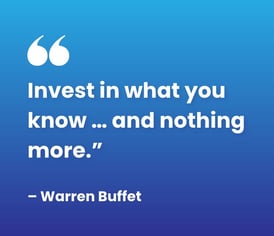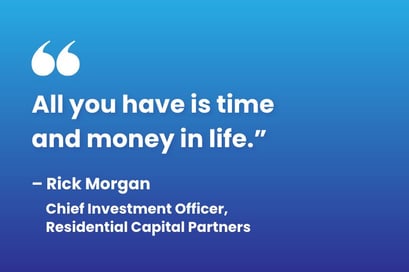
The first rule of investing: don’t lose money. The second rule: don’t forget the first. (Thank you, Warren Buffet.)
Residential Capital Partners has been in the investment-making business for over 25 years. Along with my three partners, we’ve adhered strongly to rules one and two, as well as generating several other investment principles to live by, gleaned by our own experiences—namely in respect to the importance of due diligence, rigorous financial analysis, and conservative exit expectations to mitigate risk and protect margin.
The following principles have shaped the structure and growth of Residential Capital Partners over the past 15 years, but they’re applicable for any investor, whether you’re wholesaling houses, rehabbing and flipping houses, or investing in single family rentals to build wealth.
Understand the Deal
 Peter Lynch is famous for advising to “invest in what you know.” This is easier said than done, given the readily available information at the fingertips of smartphone holders who just learned of yet another brilliant stock pick. However, most real estate investors fell in love with real estate because they can walk the property, neighborhood, and market to understand the deal. Comparatively, it usually doesn’t take long to understand the deal in real estate. If it does, then you’re probably overthinking it.
Peter Lynch is famous for advising to “invest in what you know.” This is easier said than done, given the readily available information at the fingertips of smartphone holders who just learned of yet another brilliant stock pick. However, most real estate investors fell in love with real estate because they can walk the property, neighborhood, and market to understand the deal. Comparatively, it usually doesn’t take long to understand the deal in real estate. If it does, then you’re probably overthinking it.
Just today, my partner and I were informed of an opportunity to invest in a townhome development in one of Dallas’ bedroom communities. It took us a 20 minute drive, five minutes to walk the property, and 30 seconds to determine our interest: pass. Why? It didn’t make sense to us. We didn’t understand how the developer arrived at his valuation given the surrounding neighborhood or the value of his end product relative to properties directly across the street.
As Warren Buffet would say, “Invest in what you know…and nothing more.” If you got into the real estate investment business as a wholesaler, and you are great at negotiating contracts and passing them on to a retailer for a small profit, then stick to your knitting. If you got into the real estate investment business as a retailer, gifted at taking a rehab all the way to a for-sale sign in the front yard, stick with that.
Cash is King, and Value Add is Even Better
This is one of the first principles of investing that I learned at the beginning of my career at J.P. Morgan Chase & Co. Cash is king. It smooths the way on a straightforward deal, covers hurdles in a challenging deal, and saves you during challenging times like the GFC (Global Financial Crisis) or Covid-19 pandemic.
However, cashflow with value-add opportunity is a combination that can allow you to not just produce a good rate of return—but produce a multiple on your invested dollar. Take, for example, an investment we made in a 350-slip marina that was 100% occupied and cashflow positive, yielding a good rate of return going in—and then imagine the value created by adding 100 more slips that were leased up as soon as we were done with construction.
The same concept applied to a 350-space parking garage we purchased in the middle of a vibrant commercial marketplace. We knew we would generate income from the parking (cashflow), but this property also came with air rights above the 3-story parking garage (value-add). We immediately saw how we could increase the rate of the return for our investors by expanding the property upwards of 200,000 square feet into a multi-family development. We closed on the eve of the 2008 GFC, and with the existing cashflow we were able to ride out the storm of the GFC while doing our development planning, engineering, and pre-construction all with cashflow. We never had to shut down, given the cashflow, and we came out the other side of the GFC with a development that was primed and ready to ride the upcoming growth curve of the economy.
One way to find cashflow on a project without it: use a private lender that offers 100% financing with a $0 down payment requirement.
Time And Money—That’s All You Have
My partner and the chief investment officer at Residential Capital Partners, Rick Morgan, explains the concept like so: “There are only so many hours in a day. Only so many phone calls, emails, and meetings that you can make. Managing your time to maximize the opportunity to make money is the key to success in business.” And he’s right. Successful businesspeople know how to analyze a deal quickly to determine if it’s a good use of time. Then, they move on fast.
As a firm, we developed a three-tier methodology to help us analyze opportunities. Spreading your investments between these three methodologies will allow you to realize success while maximizing your time and money.
How to Analyze Opportunities Quickly
Fast Money
|
 |
Mid-Range Investing |
Wealth Creation |
The Double-Edged Sword
It is often repeated that time is your enemy in the real estate investment business. The truth inherent in this statement is as real as it can be once you have made an investment and must turn to execution and exit. But what about before you make an investment? Can time also be your friend? We believe it can if you use discipline when making offers. Patience is, in fact, a virtue.
At the beginning of the rising interest rate environment of 2022, our firm was approached with multiple opportunities to invest in single-family developments that were slated for a traditional retail exit. As a single-family rental focused firm, we underwrote the opportunities through that investment lens. In our conversations with the developers, we ran sensitivities for a rental exit (as opposed to a for-sale exit) due to the rising interest rate environment. The developers disagreed with our sensitivity analysis and investment paradigm, so we left those negotiation tables quickly.
One year later, with interest rates and the affordable housing crisis on the rise, many of those developers came back to the table. Their offer was simple. The carrying costs were only increasing, the for-sale exit window had disappeared, but they needed a way to keep the lights on. The economics of the transaction came down to earth. The notion to build the projects for a development fee was offered willingly, and the opportunity to cashflow a build-to-rent (BTR) exit was now attractive. In this instance, time was our friend.
 |
Keep It SimpleSome of the biggest mistakes of my career were deals I dropped after overanalyzing, overthinking, and overdeveloping the opportunity. We’ve all been there. |
In June 2008, we were looking at a property along the Katy Trail in Dallas. It had a lot going for it; developing along the scenic Katy Trail was in vogue, Uptown Dallas was expanding rapidly, and the economy had not fully entered the GFC. The property was distressed with a beat-up metal barn and a crumpled brick dental office. Our plans were to raze the site, develop office condominiums backing up to the Katy Trail, and sell them to family offices that were paying high rent in the nearby financing district of Uptown. As we overanalyzed, overthought, and overdeveloped the property, the economy was growing more sensitive to the looming GFC. ‘Condo’ became a dirty word in the capital markets, and we decided to drop the deal after two months of due diligence.
The person who picked up the deal after we exited had a different idea. They painted the old metal barn a new shade of white, cobbled some new bricks onto the dilapidated dental office, and turned the property into what is now known as the Katy Trail Ice House. By keeping things simple, they turned an eyesore into one of the most successful restaurant-beer gardens in the state of Texas.
Keep it simple.
Don’t Fall In Love
As a young investor, my father told me, “There’s always another fish coming downstream.” Young investors will sometimes bend over backwards to make a deal work in their mind because they fall in love with the idea of the deal under contract: what it could become, and generate. Guilty as charged.
Likewise, there are many young investors that experience success on a development, acquisition, or project and their sin is falling in love with holding a deal when the right offer comes along. The love of the deal blinds them from realizing a profit.
Seasoned investors are immune to complication and immune to profit opportunities lost. They base their decisions on the fundamentals, keep it simple, and understand market cycles, cashflow, and taking profit off the table when the time is right. They operate this way from the experience gained and the time spent learning, succeeding, and failing.
Collaborate With the Best
There are some lessons that just about every investor learns the hard way. For everything else, there’s the option to rely on your trusted network of seasoned professionals who have done this before. In this business, relationships matter. That’s why we’ve designed our business to be more than a funds dispenser. Our goal is to help you build wealth by making sound investments. It’s why I’m proud to share our successes and lessons learned with our investors.
Don’t lose money. And don’t lose your rolodex.




